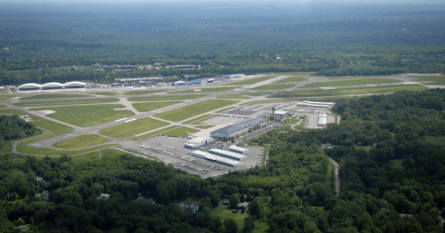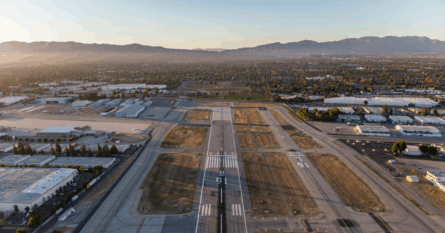by Ellie Smith / January 31, 2025
Estimated reading time: 11 minutes
If you’re wondering how to choose between first class and business class travel, look no further.
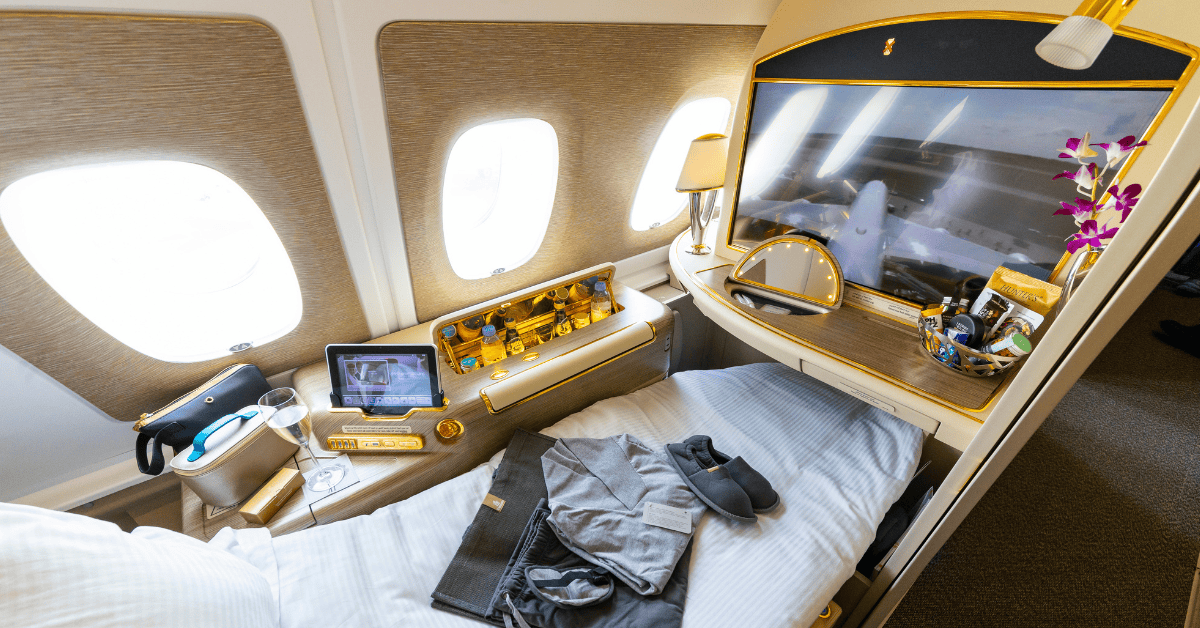
When you’re booking flights, the distance you’re traveling and the carrier you’re flying with can make all the difference to your experience in business vs. first class. Understanding the difference between these two segments – and the key details that define them – can help you make the right choices regarding your premium travel tickets.
Table of Contents
- TL;DR: Business vs. First Class Key Differences
- Business class vs. first class travel – levels of luxury
- How far are you traveling? – one of the major factors in high-end first class
- What airline are you flying? – some luxury is more decadent than others
- Seats in business class vs. first class – legroom and more
- Food and drink – what are they pouring?
- Amenities and service – the extras can make a difference
- The airport experience – first class vs. business class
- The choice between business vs. first class – final factors to consider
- Premium travel beyond the airport
TL;DR: Business vs. First Class Key Differences
Flight Distance Matters
- First class shines on long-haul international flights with private suites and top-tier service.
- On short-haul/domestic flights, differences are smaller.
Seats & Space
- Business class: Lie-flat seats, aisle access, good privacy.
- First class: Private suites, larger beds, and sometimes showers & apartments .
Food & Drinks
- Business class: Restaurant-quality meals.
- First class: Caviar, fine wine, chef-designed menus, and rare champagnes.
Airport Experience
- Business class lounges: Comfortable, free food & drinks.
- First class lounges: Michelin-star menus, spa treatments, private terminals .
Cost Factor
- First class is often 2-5x more expensive than business.
- Some airlines (Air Canada, Delta) are phasing out first class altogether.
Beyond the Airport
- No matter the choice, a Blacklane chauffeured ride keeps the sophistication going.
Business class vs. first class travel – levels of luxury
Let’s face it: The most significant jump in service and amenities occurs when you opt for business class over economy. Once you’ve decided to fly premium, first class and business class certainly feel quite similar at first glance. After all, both offer larger seats and more legroom as flagship features. Likewise, both tickets let you board the airplane early. You’ll earn similar frequent flyer miles in both classes, and flight attendants will also be busy pouring unlimited drinks in both classes.
But the similarities typically end there. Understanding the differences between first class vs business class may help you choose what really matters to you. It’s also important to realize that domestic and international first class aren’t really the same, and the differences between the classes can be amplified depending on the airline you choose.
How far are you traveling? – one of the major factors in high-end first class
The difference between business class vs first class becomes most apparent when you’re flying internationally, especially on a long-haul flight that crosses oceans and continents. First class on these flights provides significantly more privacy, space, and comfort. You can also expect gourmet meal options alongside fine wine and liquor, as well as luxurious amenities (think silk pajamas or down duvets) to enhance your comfort during the experience.
What airline are you flying? – some luxury is more decadent than others
Airlines based in the Middle East and East Asia tend to focus the most on extreme luxury in first class. Airlines such as Emirates, Singapore Airlines and Qatar Airways continue to innovate with new luxury touches to set their first class service apart. So if you want to maximize your first-class flying experience, consider those carriers in the very highest tier.
In contrast, some airlines are minimizing the difference between first class and business class. Some — like Air Canada, Air New Zealand, and Delta Airlines — have essentially eliminated first class altogether. Others, including American Airlines and United Airlines, are downsizing their first class programs in favor of expanded business class sections and services. Look for new ticket and seat category names (such as “BusinessFirst” or Virgin Atlantic’s “Upper Class”) to indicate these new hybrid categories.
Seats in business class vs. first class – legroom and more
Again the real difference in seating comes when you make the leap from economy or coach seating to business class. (Yes, some airlines offer a little more legroom in an intermediary class often known as “premium economy” — but for our purposes, those seats are still in economy class.)
On shorter or domestic flights, your business class and first class seats may seem quite similar. Both classes offer significantly more legroom and wider seats than economy and you’re likely to enjoy the smooth feel of a leather seat as well. But some real tech has gone into innovating airline seats, with architects and even yacht designers joining the industrial teams who have traditionally been involved in the creation process. In fact, in 2013 the New York Times reported that a single business-class seat can cost an airline 80,000 USD to design and manufacture – and we dread to think what inflation has done to that figure since. So it’s no wonder the seats are fundamentally the same in first and business class.
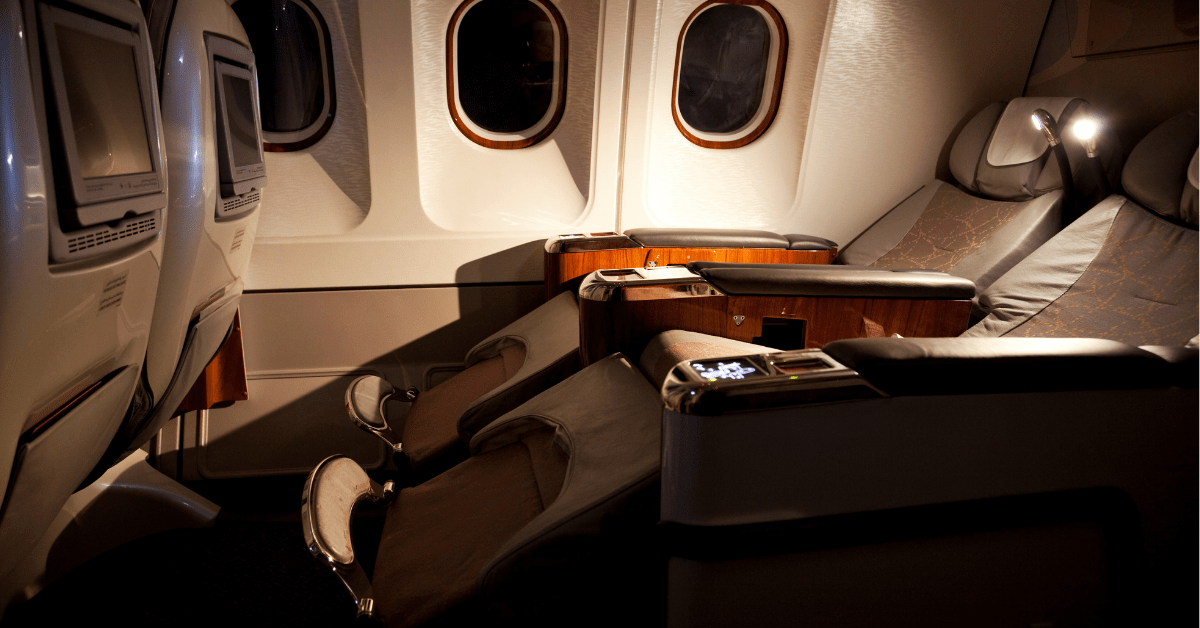
As your flight gets longer, though, the differences increase. If you’re on a long-haul international flight, your business class seat is likely to recline significantly, often becoming a completely flat bed, so you can sleep comfortably during the flight. Another big plus to high-end business class seating on long-haul flights is unencumbered direct aisle access without bothering any other passenger.
International first class on certain carriers achieves a new level of luxury — which we know can make all the difference when choosing business class vs first class. Emirates first class passengers, for example, enjoy a private cabin, as do first-class flyers on Etihad Airlines, where the “The Residence” 3-room apartment is large enough to walk around (at least a little bit) without leaving your own seating area. And Singapore Airlines’ Suites class, available on some long-haul flights, features a double bed and an onboard shower, truly leaning into the ‘hotel room in the air’ vibe.
The model of plane you’re flying on may also affect the configuration of your seating. For example, while first class on Emirates is fundamentally the same from one flight to the next, business class can vary significantly depending on the type of plane being flown on the route. If you’re opting for business class but want to make sure you understand what you’re getting, ask ahead of time to get answers regarding how close you’ll be to other passengers, whether your seat unfolds flat into a bed, and any other questions or concerns you have to support your choice of business class vs first class.
Food and drink – what are they pouring?
In the not-too-distant past, passengers in all classes could expect to enjoy a meal on board even the shortest flights. Now, however, some airlines are reserving this privilege for business class and first class passengers. Not surprisingly, you can expect a greater emphasis on fine dining and a larger range of options in first class vs business class.
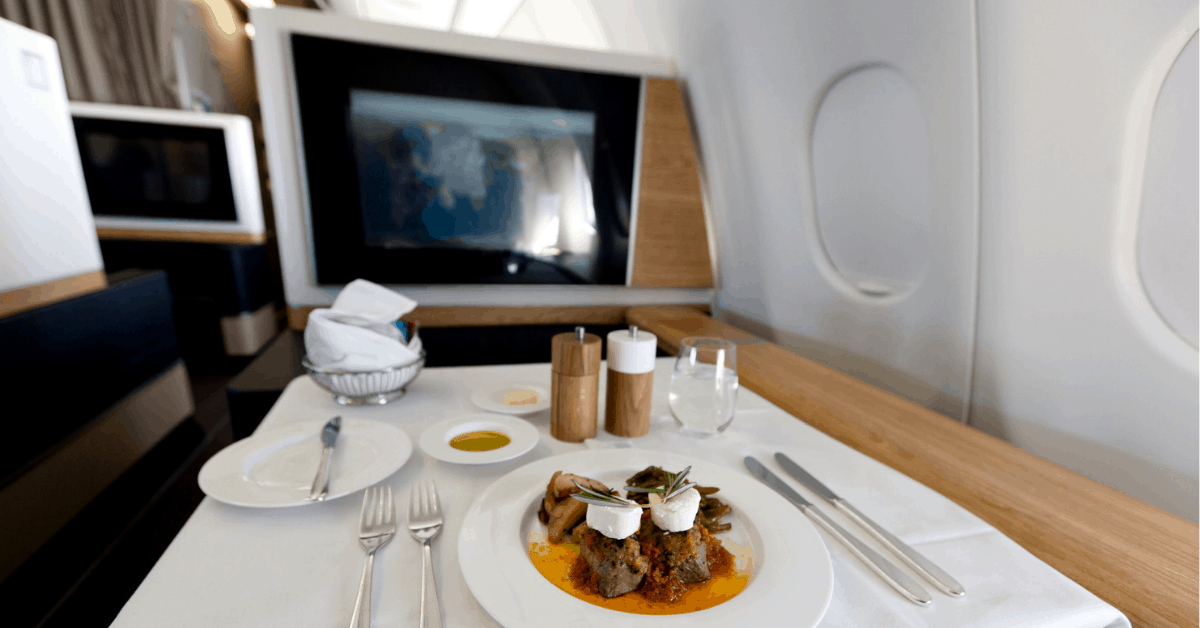
Business class food is considered to be of a good quality on most flights, especially on international routes. You can expect a restaurant-caliber meal on almost every business class flight. On some international flights, though, first class meals can be a true dining experience, with caviar and high-end Champagne served, and chefs making meals to order. In some cases, acclaimed chefs even design the first class menus.
The quality of alcohol steps up in first class as well — though this depends on the airline. For example, Qatar Airways has traditionally poured finer Champagne in business class than some airlines pour for their first class passengers. But in general, you can count on premium liquors and wines in first class, whether you prefer Dom Perignon or Hennessy Paradis.
While most first class passengers crave (and pay for) privacy, dining and drinking can become a little more social in the business class cabin. If you’re flying on Emirates, Qatar Airways, Virgin Atlantic or Korean Air, you’re likely to find a bar in the business class cabin with comfortable seating for chatting with fellow passengers, a bartender making drinks to order, and ready-to-eat snacks that might be considered a full meal downstairs in the economy cabin.
Amenities and service – the extras can make a difference
What can you expect of those small but important extras when flying business class vs first class?
While passengers in coach may end up fighting for access to the few blankets or pillows available, flight attendants in the premium classes instead hand out amenities kits as a matter of habit. Many of the amenities (for instance, eye shades, ear plugs, and toothbrushes) are designed to let you sleep and wake up in comfort. Here, too, what you receive depends largely on the airline you’ve chosen.
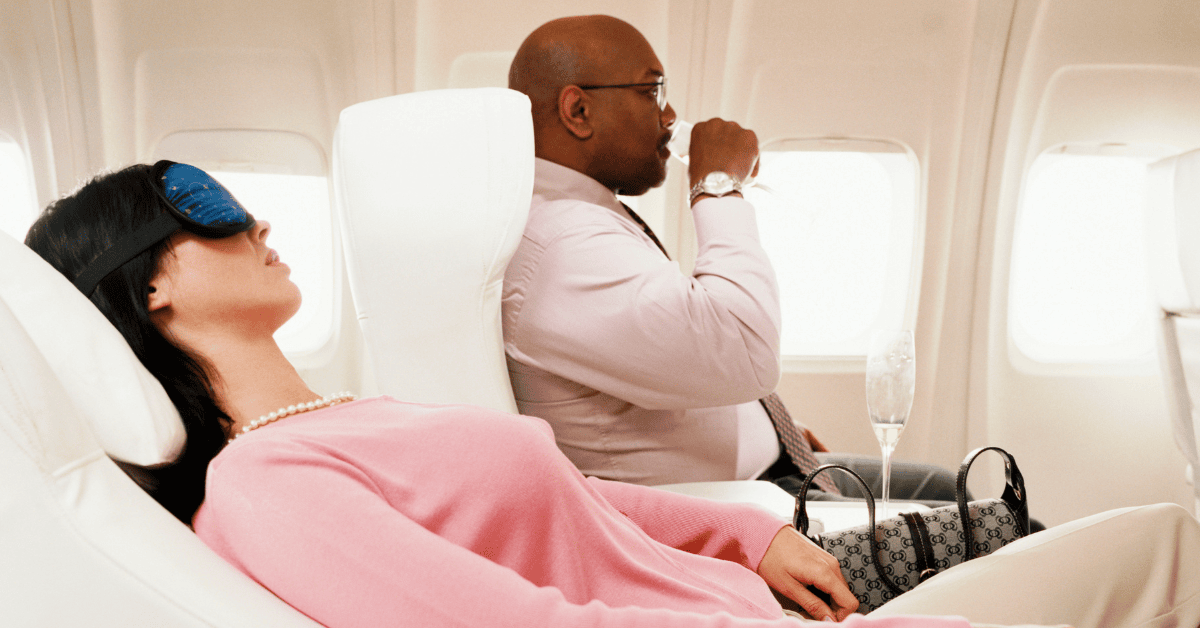
In first class, you can expect to receive more elaborate amenities. For example, you’re likely to be handed pajamas to sleep in, and toiletries in your kit may carry designer brand names.
Another perk to flying long-haul first class vs business class is the quality of the bedding. Yes, the chairs may fold flat into beds in business class, but not every airline is going to turn that flat chair into a real bed with high-end sheets and blankets. In first class, you can expect luxurious sheets with high thread counts, similar to those you’d find in a five-star hotel. The emphasis is truly on the luxurious.
Service also tends to be a little more attentive in first class, probably because each flight attendant is looking after fewer passengers. While business class doesn’t have the assembly line feel that you can experience behind the curtain in coach, flight attendants are often rushed to get through meal services. In first class, however, you’re more likely to be served meals, snacks, or drinks whenever you want them.
The airport experience – first class vs. business class
Flying either first class or business class can elevate your experience from the moment you arrive at the airport. Many airlines offer private lounges to their premium passengers, with some going all out to provide extra luxury to their first class flyers. For example, in the Air France first class lounge in Paris you can sample a menu designed by a Michelin-starred chef, as well as complimentary spa treatments. It’s truly a cut above many other lounge offerings.
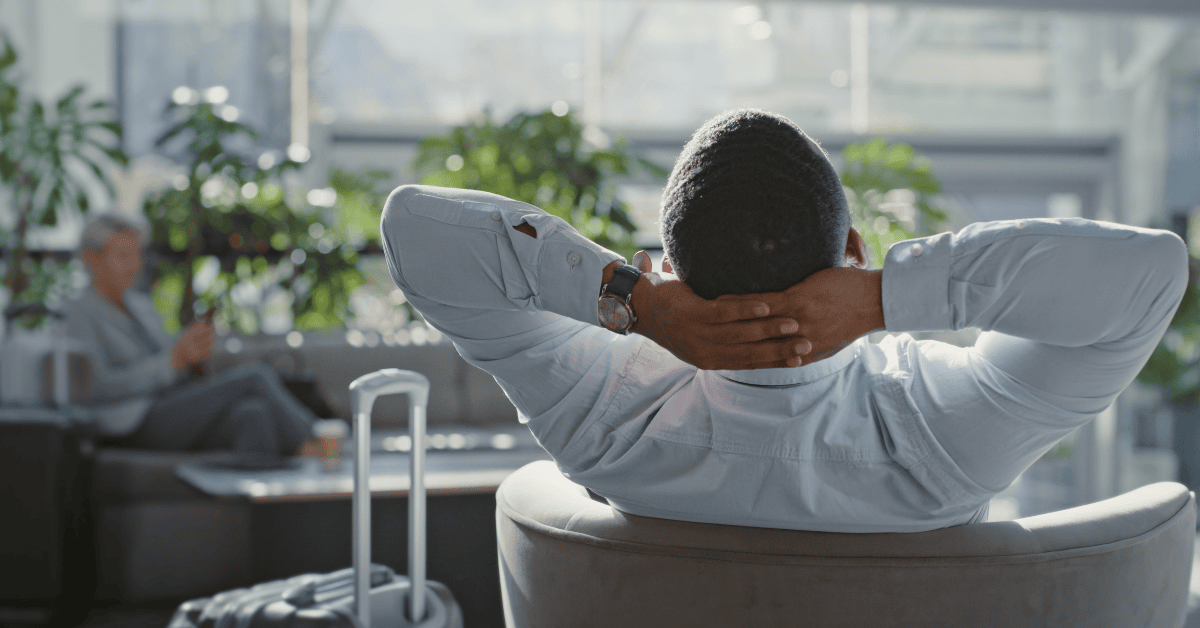
In general, look for the most luxurious first class lounges in major Asian airports, or at the home airport for a given international carrier. In a few cases, first class boarding leaves business class in the dust. For example, Lufthansa features a separate terminal for its first class passengers at Frankfurt Airport. Rather than boarding with coach or even business class flyers, these passengers are chauffeured to their plane in a Mercedes-Benz or Porsche. Elements like these add an all-important dash of luxury to the business class vs first class debate.
Business class lounges typically offer complimentary food and alcohol, free Wi-Fi and reading material, as well as comfortable seating away from the hustle and bustle of the main terminal. Some may also offer an à la carte menu or a business center, and if you’re flying through an airline’s hub, amenities including shower suites, spas, and special facilities for children are more common.
In all cases though, a first class lounge, if one is available, will provide more customized service, more extensive high-end food and drink options, and a less crowded, more luxurious space. If you expect an extended layover as you make connections, and if the serenity of a first class lounge is one of the reasons you’d choose first class over business class, check to see what lounges are actually available on your route before booking your ticket.
The choice between business vs. first class – final factors to consider
For most people, the difference in cost between a business class and first class ticket is the deciding factor. All that luxury in first class comes at a price. Typically, a first class ticket costs about double the price of a business class ticket, though in some cases, a first class seat can cost up to five times the cost of business class. Again, though, the route you’re flying can make a difference. An international business class ticket may cost more than a domestic first class ticket, depending on the route.
If you’re traveling on business, it’s also a good idea to check with your company’s expense account policies. Many corporations let employees and even consultants expense their business class flights but won’t spring for the extra costs of first class. If you’re paying for your own ticket, it’s up to you, of course.
Another major consideration when choosing to book business class vs first class is what you hope to get out of your flight. If your primary goal is to arrive at your destination well-rested and ready to leap into the business awaiting you, then business class might be your better choice. Many first class flyers, meanwhile, wish to indulge in every bit of the experience they’re paying for. While that can be supremely enjoyable, the temptation to eat or drink a little too much, just for the experience, can work against you arriving at your destination fully rested. More isn’t necessarily better.
Premium travel beyond the airport
Whether your final decision is first class or business class, premium treatment doesn’t have to stop at the edges of the airport. Extend your premium perks to the first and final legs of your journey when you book a reliable Blacklane chauffeur service to make it to your destination in comfort and style.

Blacklane makes travel effortless with transfers in hundreds of cities and airports worldwide. Say goodbye to the stress of navigating public transport or negotiating with local taxis. With us, you’ll enjoy direct, seamless rides from the airport to your destination. Our expert chauffeurs track your flight, so they’re always on time, even if plans change. Hand-picked for their local knowledge, they’re ready to share insider tips to help you make the most of your trip.
ABOUT THE AUTHOR
Ellie Smith
Ellie is an avid traveler, writer, and adventurer, with a passion for exploring the world and sharing her experiences through storytelling. Working for global chauffeur company Blacklane and having lived in cities like Dubai and Berlin, she has gained valuable first-hand experience in uncovering hidden gems worldwide.


